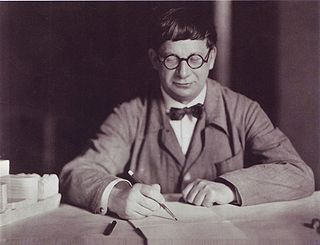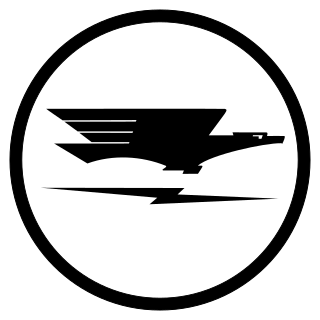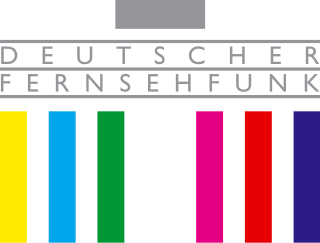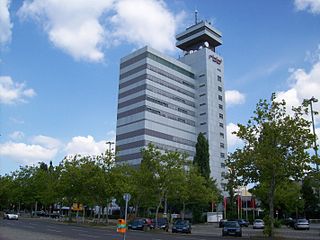
ARD is a joint organisation of Germany's regional public-service broadcasters. It was founded in 1950 in West Germany to represent the common interests of the new, decentralised, post-war broadcasting services – in particular the introduction of a joint television network.

RIAS was a radio and television station in the American Sector of Berlin during the Cold War. It was founded by the US occupational authorities after World War II in 1946 to provide the German population in and around Berlin with news and political reporting.

Hans Poelzig was a German architect, painter and set designer.
The Berliner Rundfunk (BERU) was a radio station set in East Germany. It had a political focus and discussed events in East Berlin. Today it is a commercial radio station broadcast with the name "Berliner Rundfunk 91.4".
Television in Germany began in Berlin on 22 March 1935, broadcasting for 90 minutes three times a week. It was home to the first public television station in the world, named Fernsehsender Paul Nipkow.

Norddeutscher Rundfunk, commonly shortened to NDR, is a public radio and television broadcaster, based in Hamburg. In addition to the city-state of Hamburg, NDR broadcasts for the German states of Lower Saxony, Mecklenburg-Vorpommern and Schleswig-Holstein. NDR is a member of the ARD organisation.

Rundfunk Berlin-Brandenburg, commonly shortened to RBB, is an institution under public law for the German states of Berlin and Brandenburg, based in Berlin and Potsdam. RBB was established on 1 May 2003 through the merger of Sender Freies Berlin (SFB) and Ostdeutscher Rundfunk Brandenburg (ORB), based in Potsdam, and is a member of the Association of PSBs in the Federal Republic of Germany (ARD).

Sender Freies Berlin was the ARD public radio and television service for West Berlin from 1 June 1954 until 1990 and for Berlin as a whole from German reunification until 30 April 2003. On 1 May 2003 it merged with Ostdeutscher Rundfunk Brandenburg to form Rundfunk Berlin-Brandenburg.

Ostdeutscher Rundfunk Brandenburg, based in Potsdam, was the public broadcaster for the German federal state of Brandenburg from 12 October 1991 until 30 April 2003. It was a member organization of the consortium of public-law broadcasting organizations in Germany, ARD.

Rundfunk der DDR was the collective designation for radio broadcasting organized by the State Broadcasting Committee in the German Democratic Republic (GDR) until German reunification in 1990.

Westend is a locality of the Berlin borough Charlottenburg-Wilmersdorf in Germany. It emerged in the course of Berlin's 2001 administrative reform on the grounds of the former Charlottenburg borough. Originally a mansion colony, it is today a quite densely settled, still affluent territory adjacent to Berlin's inner city in the east.
PRIX EUROPA – The European Broadcasting Festival – is the Europe's largest annual tri-medial festival and competition. The event takes place in the third week of October in Berlin, Germany.

The Reichs-Rundfunk-Gesellschaft was a national network of German regional public radio and television broadcasting companies active from 1925 until 1945. RRG's broadcasts were receivable in all parts of Germany and were used extensively for Nazi propaganda after 1933.

Deutscher Fernsehfunk was the state television broadcaster in the German Democratic Republic from 1952 to 1991.

RBB Fernsehen is a German free-to-air television channel owned and operated by Rundfunk Berlin-Brandenburg (RBB) and serving Berlin and Brandenburg. It is one of the seven regional "third programmes" that are offered within the federal ARD network.

Theodor-Heuss-Platz is a large city square in the Westend district of Berlin, Germany. It is named after Theodor Heuss (1884–1963), the first President of Germany after World War II.
RBB Berlin was the third television channel for Berlin, Germany from October 1992 until March 2004. Until May 2003 it was owned by Sender Freies Berlin (SFB), then by its successor, Rundfunk Berlin-Brandenburg (RBB), under the provisional name RBB Berlin. On 1 March 2004, the two previous regional television channels RBB Berlin and RBB Brandenburg were replaced by the new rbb Fernsehen.
RBB Brandenburg was the third television channel for Brandenburg, (Germany) from January 1992 to March 2004. Until May 2003, it was organized by Ostdeutscher Rundfunk Brandenburg (ORB), then by its successor, Rundfunk Berlin-Brandenburg (RBB). On 1 March 2004, the two regional television channels of RBB – RBB Brandenburg and RBB Berlin – were integrated into the new rbb Fernsehen.

Helga "Big Helga" Hahnemann was an East German multi-faceted stage performer and entertainer. She came to wider prominence through her television and radio appearances after 1962. By the time reunification arrived in 1990 she had become a leading star of the small screen in East Germany. She fell terminally ill and then died shortly afterwards, possibly because of the extent of her addiction to cigarettes: she was 54. Her death left unanswered the question of how successfully her performances might have captivated pan-German television audiences post unification.
The Sorbischer Rundfunk is the Sorbian language program of Mitteldeutscher Rundfunk (MDR) and Rundfunk Berlin-Brandenburg (RBB), both of which are regional public broadcaster in Germany. It is the only broadcast in a national minority language in Germany.















